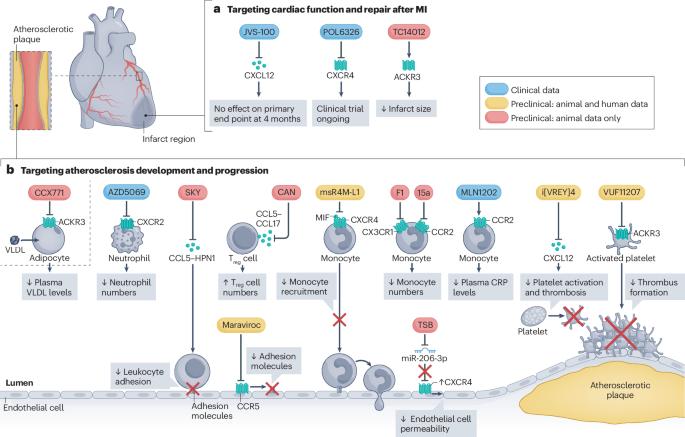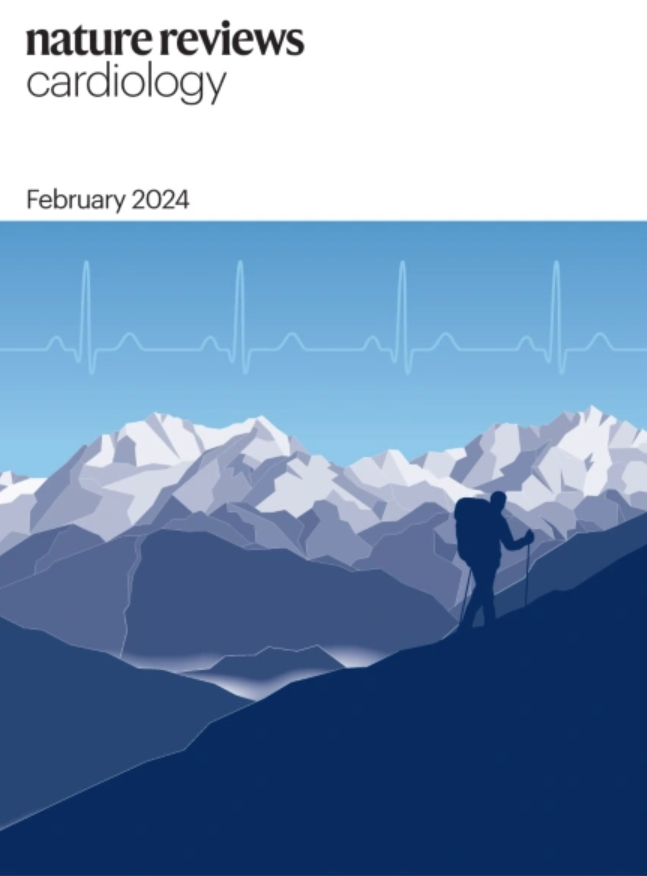以动脉粥样硬化中的免疫细胞招募为目标
IF 41.7
1区 医学
Q1 CARDIAC & CARDIOVASCULAR SYSTEMS
引用次数: 0
摘要
动脉粥样硬化是心肌梗死和中风的主要根本原因。动脉粥样硬化性心血管疾病的特征是大中型动脉的慢性炎症反应,其发生和持续的动力来自浸润内皮下空间的白细胞。动脉内膜中的高脂血症和脂蛋白潴留引发内皮细胞活化,导致促炎性白细胞在动脉壁上聚集,促进动脉粥样硬化的发展。这种炎症反应是由一系列可溶性介质(即细胞因子和趋化因子)协调的,它们在局部和全身扩大了炎症反应,并得到了调节白细胞归巢、粘附和转运的组织特异性分子的补充。尽管小鼠模型提供了大量证据,但只有少数针对动脉粥样硬化中白细胞的疗法在人体中进行了评估。这些疗法的临床转化面临的主要挑战包括缺乏组织特异性和抑制策略的选择性不足。在这篇综述中,我们将讨论有关受体配体对以及调节白细胞流入发炎动脉壁的相互作用因子的最新研究,主要侧重于使用药物干预的研究。我们还讨论了促进炎症消退的机制,并强调了这些研究领域的主要发现如何有望成为动脉粥样硬化性心血管疾病的潜在治疗策略。本文章由计算机程序翻译,如有差异,请以英文原文为准。


Targeting immune cell recruitment in atherosclerosis
Atherosclerosis is the primary underlying cause of myocardial infarction and stroke. Atherosclerotic cardiovascular disease is characterized by a chronic inflammatory reaction in medium-to-large-sized arteries, with its onset and perpetuation driven by leukocytes infiltrating the subendothelial space. Activation of endothelial cells triggered by hyperlipidaemia and lipoprotein retention in the arterial intima initiates the accumulation of pro-inflammatory leukocytes in the arterial wall, fostering the progression of atherosclerosis. This inflammatory response is coordinated by an array of soluble mediators, namely cytokines and chemokines, that amplify inflammation both locally and systemically and are complemented by tissue-specific molecules that regulate the homing, adhesion and transmigration of leukocytes. Despite abundant evidence from mouse models, only a few therapies targeting leukocytes in atherosclerosis have been assessed in humans. The major challenges for the clinical translation of these therapies include the lack of tissue specificity and insufficient selectivity of inhibition strategies. In this Review, we discuss the latest research on receptor–ligand pairs and interactors that regulate leukocyte influx into the inflamed artery wall, primarily focusing on studies that used pharmacological interventions. We also discuss mechanisms that promote the resolution of inflammation and highlight how major findings from these research areas hold promise as potential therapeutic strategies for atherosclerotic cardiovascular disease. In this Review, the authors discuss the receptors, ligands and interactors that regulate immune cell recruitment in atherosclerosis, describe mechanisms that promote the resolution of inflammation in atherosclerotic lesions, and highlight potential strategies to target these pathways for the treatment of atherosclerotic cardiovascular disease.
求助全文
通过发布文献求助,成功后即可免费获取论文全文。
去求助
来源期刊

Nature Reviews Cardiology
医学-心血管系统
CiteScore
53.10
自引率
0.60%
发文量
143
审稿时长
6-12 weeks
期刊介绍:
Nature Reviews Cardiology aims to be the go-to source for reviews and commentaries in the scientific and clinical communities it serves. Focused on providing authoritative and accessible articles enriched with clear figures and tables, the journal strives to offer unparalleled service to authors, referees, and readers, maximizing the usefulness and impact of each publication. It covers a broad range of content types, including Research Highlights, Comments, News & Views, Reviews, Consensus Statements, and Perspectives, catering to practising cardiologists and cardiovascular research scientists. Authored by renowned clinicians, academics, and researchers, the content targets readers in the biological and medical sciences, ensuring accessibility across various disciplines. In-depth Reviews offer up-to-date information, while Consensus Statements provide evidence-based recommendations. Perspectives and News & Views present topical discussions and opinions, and the Research Highlights section filters primary research from cardiovascular and general medical journals. As part of the Nature Reviews portfolio, Nature Reviews Cardiology maintains high standards and a wide reach.
 求助内容:
求助内容: 应助结果提醒方式:
应助结果提醒方式:


